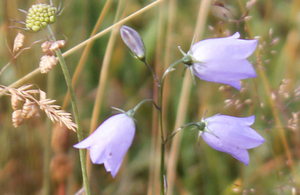One in five vascular plant species are threatened with extinction
'A Vascular Plant Red List for England' was launched at Kew Gardens today, presenting a comprehensive and objective analysis of changes in the distribution of our native flora to identify our most threatened species.

Harebell © Natural England
The new Red List reveals that a fifth of England’s wildflower species are under threat, with the majority of these threatened species suffering a decline of 30% or more. Wildflowers associated with infertile soils, open habitats or highly acid or basic habitats, such as great sundew (Drosera anglica) or burnt-tip orchid (Orchis ustulata), fare particularly badly. The analysis also identifies species that have suffered such severe declines in lowland areas of England that they meet the ‘threatened’ criteria, despite being still relatively widespread and common in upland areas. These include the frog orchid (Coeloglossum viride), grass-of-Parnassus (Parnassia palustris) and common butterwort (Pinguicula vulgaris).
One major cause for concern is that a suite of wildflowers, once common and widespread across England have now declined across their entire range and are now close to being listed as threatened. These include familiar species such as as ragged-robin (Silene flos-cuculi), harebell (Campanula rotundifolia), quaking grass (Briza media), common rock-rose (Helianthemum nummularium) and cross-leaved heath (Erica tetralix).
The Red List is the product of a partnership of 12 scientists from the Botanical Society of Britain and Ireland (BSBI), Natural England, the Centre of Ecology and Hydrology, the Natural History Museum, Plantlife and Royal Botanic Gardens, Kew.
Red List lead author Dr Pete Stroh (BSBI) said “Whilst many of these ‘near threatened’ species are still found within nature reserves, they once had a much greater presence outside of protected areas. Following the widespread destruction or modification of vast swathes of unprotected countryside - particularly in lowland England - over the past 60 years, it is perhaps not so surprising to find out that these species have undergone such severe declines”.
Ian Taylor, specialist for the conservation of vascular plant species at Natural England, said: “The scientific rigour brought to the England Red List by a partnership of the country’s leading botanical organisations will enable us to target our conservation efforts more precisely and with greater confidence on those plants, habitats and landscapes revealed to be most urgently in need.”
The new Red List will play a vital role in helping Natural England to identify additional country-level priority taxa requiring conservation action, whether through appropriate management of Sites of Special Scientific Interest (SSSI), designation of new SSSIs, targeting of agri-environment schemes and land management advice in the ‘wider countryside’, or projects funded by the Species Recovery Programme (SRP).
For more information, view the report on the BSBI’s website.